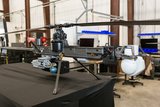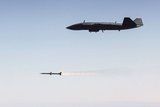Camcopter S-100 completes extensive German Navy flight trials
Building on its unrivalled position as a proven VTOL Maritime UAS, the CAMCOPTER S-100 has recently completed its toughest test to date, three weeks of demanding flights in the Baltic Sea onboard the new K130 Class Corvettes of the German Navy.
The German Forces have, as do other NATO nations, a recognised capability gap for Intelligence, Surveillance, Target Acquisition and Reconnaissance (ISTAR) platforms that in particular could be filled by unmanned aerial systems. As part of the German Navy’s strategy to fill this gap in the maritime environment and use Unmanned Air Vehicle Systems (UAS) in their future Force Mix, the German MoD decided to conduct integration trials of the CAMCOPTER S-100 onboard the new K130 Class Corvettes of the German Navy. In particular, these trials were to substantiate the integration and operation of a Vertical Takeoff and Landing (VTOL) UAS and to start to formulate the Concept of Operations (CONOPS) for employing this UAS.
After a thorough phase of investigation and market research by the German MoD, which took place during 2006 and 2007, the CAMCOPTER S-100 from the Austrian Company Schiebel was chosen as a basis for further work. It has been in service with several countries since 2006 and has previously been proven in the seagoing environment with Indian, Pakistani and Spanish Maritime agencies. Compared to its competitors, it offers the Maritime Forces a proven and reliable system in the harsh environment of operating at sea. It has a Maximum Take Off Weight (MTOW) of 200 kg, can carry 50 kg of payloads and, with an operating radius of up to 180 km, provides endurance in excess of 6 hours. Whether the requirement is Force Protection or Force Projection, either in the littoral or beyond sight of land, the CAMCOPTER S-100 is ideally suited.
As part of a study contract, three one-week campaigns took place during the summer of 2008 in the Baltic Sea. The campaigns proceeded exactly as planned without incident and of note, the test parameters were extended beyond the original requirements. Indeed, both parties can report that the campaigns have been an impressive success for both the German Navy and for Schiebel. The tests proved essential for de-risking the operation of UAS at sea to date as well as supporting the development of concepts on how the German Navy will efficiently and effectively employ UAS for reconnaissance at sea.
In all, the CAMCOPTER S-100 completed more than 130 takeoffs in a total flight time of more than 20 hours, landings from the “single spot” corvettes with relative winds from all possible directions (both ahead and abaft the beam). The relative wind speeds were as high as 40 knots over the flight deck, at more than 8 degrees roll angle of the K130 Class
Corvettes and MTOWs in excess of 190 kg. Of significance, the CAMCOPTER S-100 comfortably withstood roll angles of the flight deck in excess of +/- 15 degrees, even with a wet flight deck at times. The results were well in excess of expectations and trial requirements.
In summary, both parties are extremely pleased to report that the unique and challenging UAS trials on board the K130 Class Corvettes on the waters of the Baltic Sea using the Schiebel CAMCOPTER S-100 VTOL UAS have been successfully completed with the objectives achieved. The trial has been a major step forward in developing the requirements for the utilization of the CAMCOPTER S-100 Unmanned Aerial Vehicle Systems in the maritime environment by the German Navy.
More from Uncrewed Vehicles
-
![What's next for the Pentagon after the Replicator programme?]()
What's next for the Pentagon after the Replicator programme?
Although the Replicator initiative has made several accomplishments, there are still multiple gaps to plug across the US Department of Defense (DoD) and its services.
-
![Cummings Aerospace showcases Hellhound loitering munition designed for US Army’s LASSO programme (video)]()
Cummings Aerospace showcases Hellhound loitering munition designed for US Army’s LASSO programme (video)
Cummings Aerospace presented its turbojet-powered Hellhound loitering munition at SOF Week 2025, offering a man-portable solution aligned with the US Army’s LASSO requirements.
-
![SOF Week 2025: PDW unveils attritable FPV drone for SOF operations at scale]()
SOF Week 2025: PDW unveils attritable FPV drone for SOF operations at scale
PDW has revealed its Attritable Multirotor First Person View drone at SOF Week 2025, offering special operations forces a low-cost, rapidly deployable platform for strike and ISR missions, inspired by battlefield lessons from Ukraine.
-
![SOF Week 2025: Teledyne FLIR white paper provides guidance on reusable loitering munitions]()
SOF Week 2025: Teledyne FLIR white paper provides guidance on reusable loitering munitions
Teledyne FLIR is highlighting the emerging requirements for 'recoverable and re-usable' loitering munitions across the contemporary operating environment during this week’s SOF Week conference in Tampa, Florida.
-
![SOF Week 2025: Kraken Technology group debuts K3 Scout USV in North America]()
SOF Week 2025: Kraken Technology group debuts K3 Scout USV in North America
High-performance maritime industry player Kraken Technology Group, based in the UK, has used the SOF Week conference in Tampa, Florida this week to debut its K3 Scout uncrewed surface vessel (USV) to the North American market.
-
![Palladyne AI and Red Cat to demonstrate capabilities for autonomous drone swarms to the US military]()
Palladyne AI and Red Cat to demonstrate capabilities for autonomous drone swarms to the US military
Red Cat and Palladyne AI recently conducted a cross-platform collaborative flight involving three diverse heterogeneous drones.

























